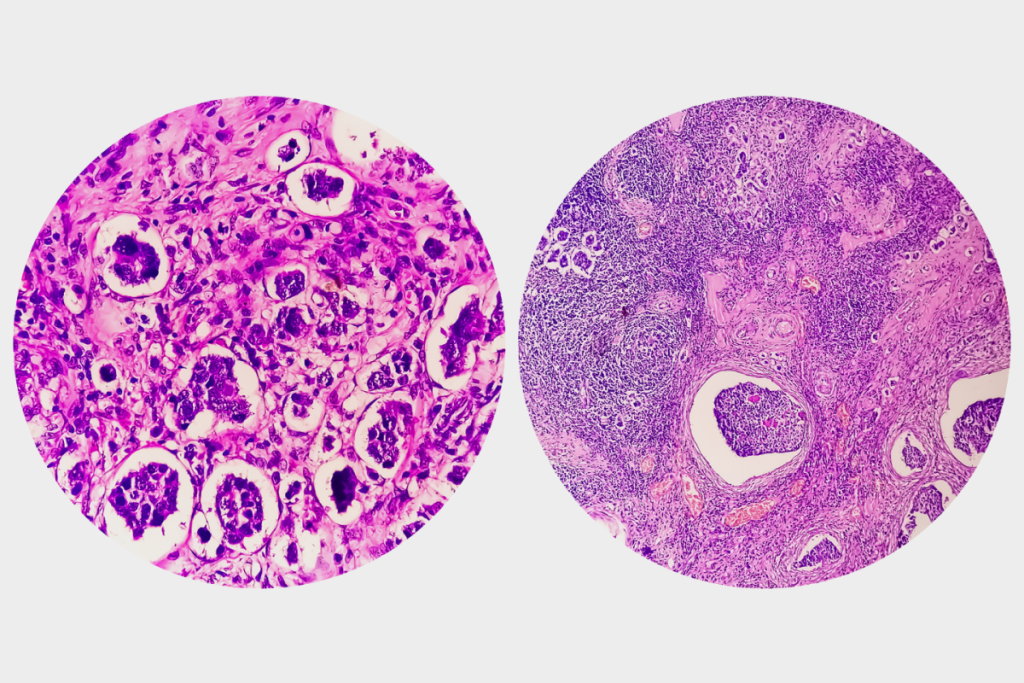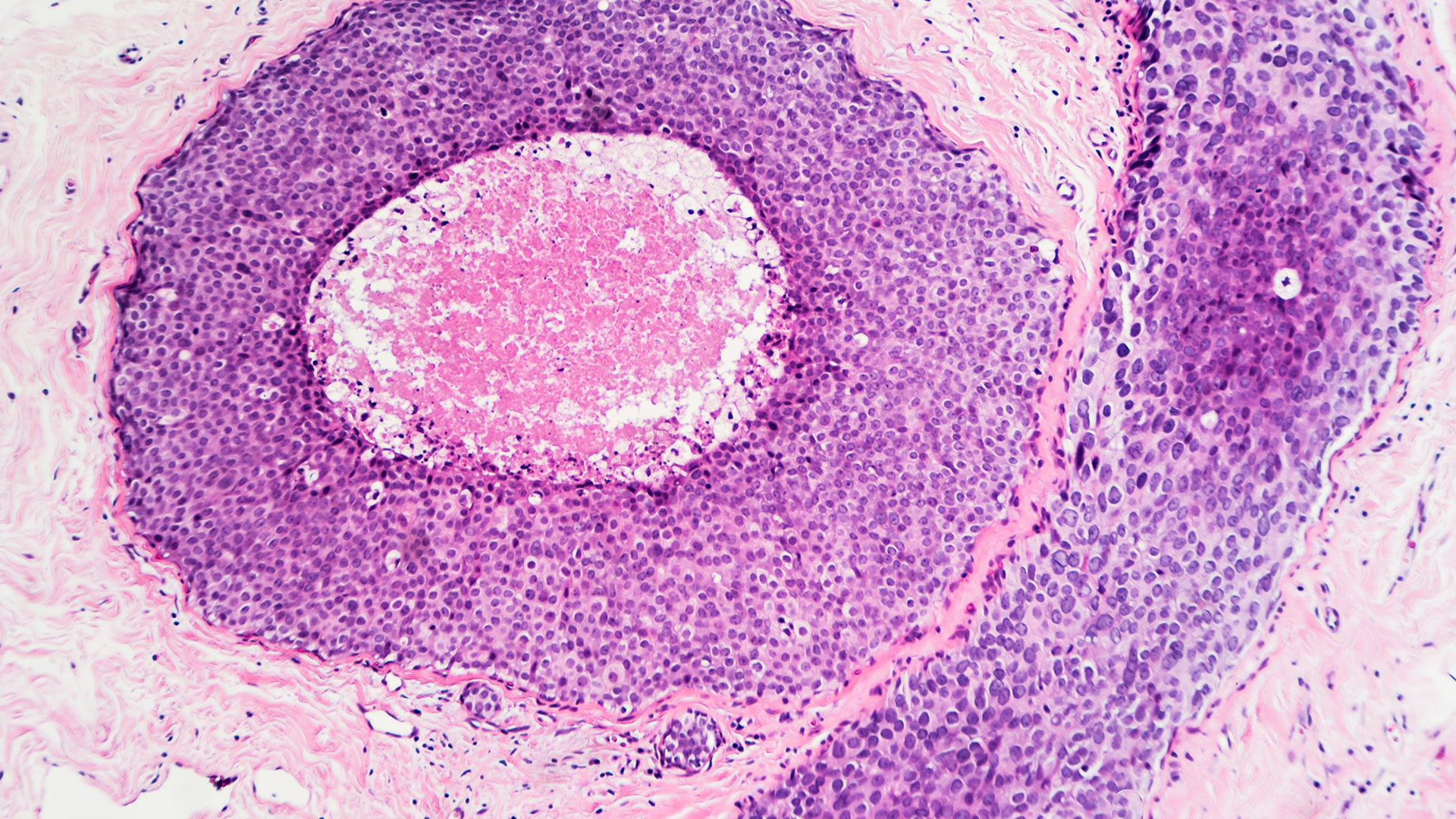Ductal carcinoma
This type of breast cancer begins in the cells lining the milk ducts of the breast. There are two main types of ductal carcinoma:
- Ductal Carcinoma In Situ (DCIS): This is a non-invasive form of breast cancer where the cancer cells are confined within the ducts and have not spread into the surrounding breast tissue. However, it IS breast cancer and definitely has the potential to become Invasive Ductal Carcinoma (IDC).It’s often referred to as stage 0 breast cancer.
- Invasive Ductal Carcinoma (IDC): This is the most common form of breast cancer. In IDC, cancer cells have spread beyond the ducts into the surrounding breast tissues. This breast cancer can spread to other parts of the body. It accounts for 80-90% of all breast cancers. Because IDC is the most common type of breast cancer we will dicuss it first and then talk about DCIS.

How IDC Starts
IDC begins when cells in the milk ducts start to grow uncontrollably and form a tumor. Over time, these cancerous cells break through the duct walls and invade the surrounding breast tissue. If not detected and treated early, IDC can spread to lymph nodes and other parts of the body, or (less common) it can start as DCIS and then progress into IDC.
Standard of Care Treatments
Early-Stage IDC
Early-stage IDC (stages I and II) is typically treated with a combination of the following therapies:
- Surgery: This may involve a lumpectomy (removal of the tumor and a small margin of surrounding tissue) or a mastectomy (removal of the entire breast).
- Radiation Therapy: Often used after lumpectomy to destroy any remaining cancer cells and reduce the risk of recurrence.
- Hormone Therapy: If the cancer is hormone receptor-positive, medications like tamoxifen or aromatase inhibitors may be used to block the effects of estrogen.
- HER2-Targeted Therapy: For HER2-positive cancers, drugs like trastuzumab (Herceptin) can be used to target the HER2 protein and slow cancer growth.
- Chemotherapy: May be used to kill cancer cells or shrink tumors before surgery.
Late-Stage IDC
Late-stage IDC (stages III and IV) is treated with more aggressive treatments:
- Chemotherapy: Often used as the first line of treatment to shrink tumors and control the spread aggressive IDC when higher-grade larger tumors & lymph nodes are involved. (see side effects above)
- Targeted Therapy: Drugs that specifically target cancer cells, such as those targeting HER2 or other specific molecules.
- Hormone Therapy: For hormone receptor-positive cancers, continued use of hormone-blocking medications.
- Radiation Therapy: To control symptoms and improve quality of life. (see side effects above)
- Surgery: In some cases, surgery may be used to remove tumors or alleviate symptoms.
- Immunotherapy: Uses the body’s immune system to fight cancer. Treatments include monoclonal antibodies, checkpoint inhibitors, and CAR-T cell therapy. It often has autoimmune-like side effects.
IDC Recurrence Rate
5-Year Recurrence Rate
- Stages I and II: About 10-15%
- Stage III: Around 30-40%
- Metastatic Stage IV: 31%
10-Year Recurrence Rate
- Stages I and II: Approximately 15-20%
- Stage III: Around 40-50%.
- Metastatic Stage IV: 50%
Breast Cancer Treatments
Survival Rates if IDC (based on Standard of Care Treatment)
5-year survival rates:
- Stage I and II: 98% 3% of women die in 5 years
- Stage III: About 72% 28% of women die in 5 years
- Metastatic Stage IV: Around 28 72% of women die in 5 years
10-year survival rates:
- Stage I and I: Approximately 85-90% 10-15% of women die in 10 years
- Stage III: Around 50-60% 40-50% of women die in 10 years
- Metastasis Stage IV: Approximately 10-20% 80-90% of women die in 10 years
BCA recommends women evaluate Standard of Care Side Effects, Breast Cancer Treatments and Breast Cancer Reconstruction (pink text at the bottom of this page are interlinks for you) options thoroughly before making any decisions.

Ductal Carcinoma In Situ (DCIS)
DCIS often referred to as “stage 0” breast cancer, is a condition where abnormal cells are found in the lining of a breast duct, but have not spread outside the duct into the surrounding breast tissue.
How It Starts
DCIS begins when cells in the milk ducts start to grow uncontrollably. These cells remain confined within the ducts and do not invade the surrounding breast tissue. It’s often detected through a mammogram, which can show tiny flecks of calcium called calcifications.
DCIS Standard of Care Treatments
Early-stage (0-II)
- Breast-Conserving Surgery (BCS): Also known as a lumpectomy, this involves removing the tumor and a small margin of surrounding tissue. It’s often followed by radiation therapy to lower the risk of recurrence.
- Mastectomy: In some cases, especially if the DCIS is widespread, a simple mastectomy (removal of the entire breast) may be recommended.
- Radiation Therapy: Typically used after BCS to destroy any remaining cancer cells and reduce the risk of recurrence.
- Hormone Therapy: If the DCIS is hormone receptor-positive, medications like tamoxifen may be used to block the effects of estrogen.
Early Stage Recurrence Rate
Typically below 15% when treated with lumpectomy + radiation, however recurrence is more likely within 10 years of diagnosis.
Late-Stage (III-IV)
Late-stage DCIS is rare, as DCIS is usually detected early through screening. However, if it progresses or is initially misdiagnosed, more aggressive treatments may be needed:
- Chemotherapy: Used to kill cancer cells or shrink tumors.
- Targeted Therapy: Drugs that specifically target cancer cells, such as those targeting HER2 or other specific molecules.
- Radiation Therapy: To control symptoms and improve quality of life.
- Surgery: To remove tumors or alleviate symptoms.
- Immunotherapy: Uses the body’s immune system to fight cancer.
BCA recommends women evaluate Standard of Care Side Effects, Breast Cancer Treatments and Breast Cancer Reconstruction (all blue text is interlinks) options thoroughly before making any decisions.

Recurrence Rate
With radiation the recurrence rate: Less than 15% over 10 years when treated with lumpectomy + radiation
Without radiation: Recurrence risk increases significantly—especially for high-grade or large tumors
Invasive recurrence: About 50% of DCIS recurrences are invasive breast cancer
Timing: Most recurrences occur within 10 years of initial diagnosis
BCA believes most recurrence is caused by re-exposure to the same environmental chemicals that caused the original breast cancer. Doctors do not discuss this with their breast cancer patients, therefore they do nothing to help their patients avoid recurrence outside of recommending chemo/radiation/ hormone suppressors.
Survival Rates
Early-Stage
- 5-10 year survival rate: Approximately 75-82%.
Late-Stage DCIS becomes IDC; the survival statistics are similar:
The 5-year survival rates for IDC:
- Stage I and II: 97% – 3% of women die
- Stage III: About 72% – 28% of women die
- Metastatic Stage IV: Around 28% – 72% of women die
The 10-year survival rates for IDC
- Stage I and II: Approximately 85-90%
- Stage III: Around 50-60%
- Stage IV: Approximately 10-20% – 80-90% of women die
Empower Yourself Now!
Your Breast Cancer Beating Tool Box
Emotional Support is critical to your healing. Even if everything goes smoothly with your treatment a cancer diagnosis is stressful. Reach out to your support network to help you emotionally on a regular basis. A Therapist helps a lot.
And use Duality to fill in the gaps!
References
- Acibadem Health Point, IDC survival rates
- Cleveland Clinic, Provides IDC stages and survival rates
- Cancer Treatment Centers of America, DCIS & IDC survival rates,


